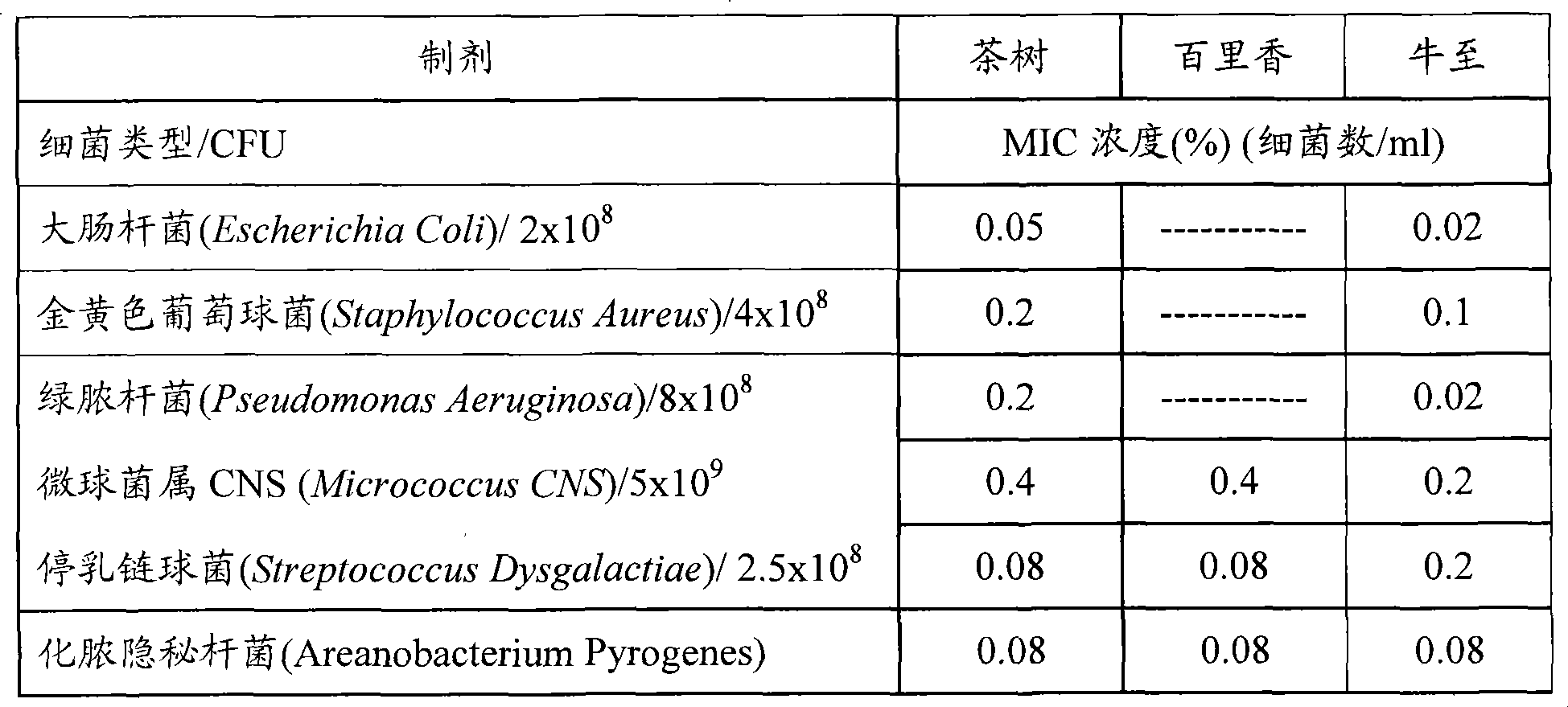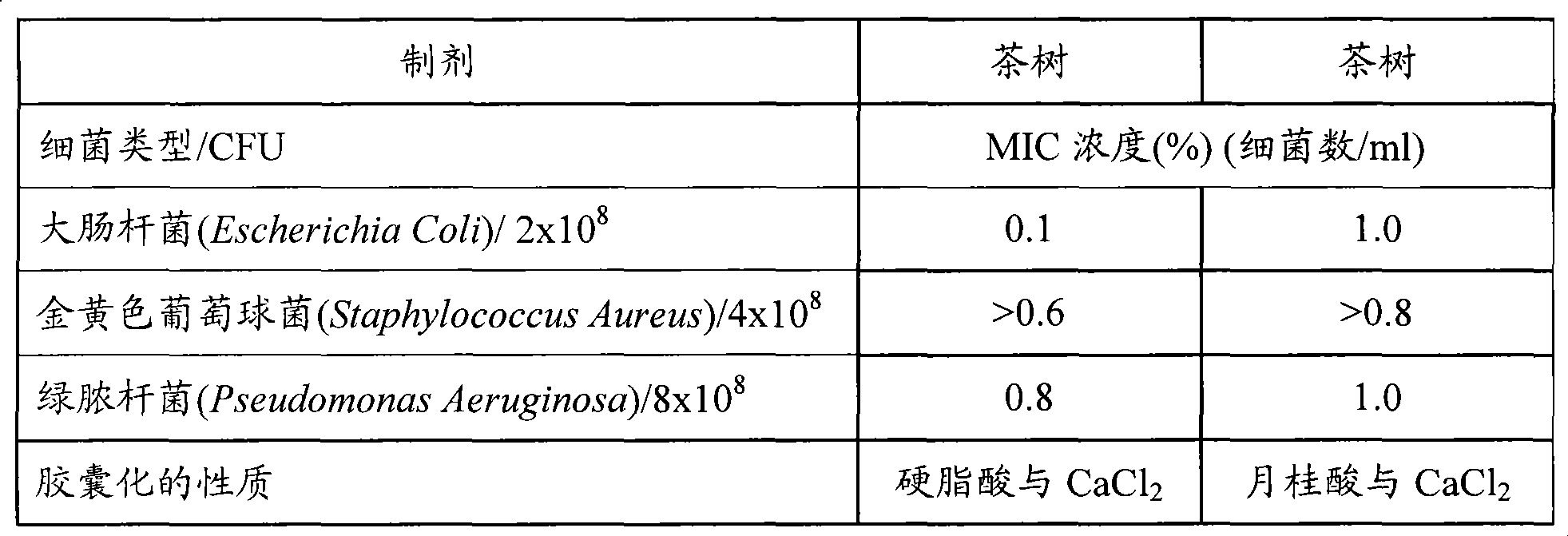Applications of microencapsulated essential oils
A microencapsulation and microencapsulation technology, applied in the direction of microcapsules, microcapsule preparations, applications, etc., can solve the problems that essential oil preparations are difficult to control, essential oils have poor volatility and water solubility, and are easy to oxidize.
- Summary
- Abstract
- Description
- Claims
- Application Information
AI Technical Summary
Problems solved by technology
Method used
Image
Examples
Embodiment 1
[0170]Using a high shear mixer, a solution of 35 g of toluene diisocyanate (TDI) mixed with 250 g of essential oils (Table 1 ) was added to 500 g of water containing 5 g of polyvinyl alcohol (PVA). To this was added 120 ml of water with 55.6 g of polyethylene glycol (PEG) 4000. Mixing was continued for 2 hours at room temperature. The resulting emulsion was treated with 12 g of guar gum and 4 g of Nefocide. To break the hydrogel viscosity of the emulsion, 10 g of 1% sodium dodecyl sulfate (SDS) was added.
[0171] In order to evaluate its antimicrobial efficacy, particularly in the treatment of mastitis, the formulation was next tested on a variety of microorganisms.
[0172] In general, the formulation was found to be an effective antimicrobial formulation, with efficacy against all pathogens tested.
Embodiment 2
[0174] 12 g stearic acid dissolved in 100 g essential oil was added to rapidly stirred (high shear mixer) containing 2.5 g polyvinyl alcohol (PVA) in 250 ml H 2 O solution. To it, add 22.8g CaCl 2 Hexahydrate in 20ml H 2 O and stirred for 2 hours. Then, 1.5 g methylparaben, 8 ml Latron B 1956 and 3 g guar gum were added and stirring was continued for a further 2 hours.
[0175] Microcapsules containing other essential oils were similarly prepared:
[0176] 1- Tea tree oil, encapsulated in lauric acid, with CaCl 2 ;
[0177] 2- Thyme oil, encapsulated in stearic acid, with CaCl 2 ;
[0178] 3- Eucalyptus, encapsulated in stearic acid, with CaCl 2 , containing free (with free) pyrethrum and sesame oil;
[0179] 4- Oil of oregano, encapsulated in capric acid, with CaCl 2 , containing free pyrethrum and sesame oil;
[0180] 5-Tea tree oil, encapsulated in capric acid, with FeCl 2 ;
[0181] 6- Citronella oil, encapsulated in lauric acid, using MgCl 2 , containing fre...
Embodiment 3
[0202] Essential oils such as tea tree oil, eucalyptus oil, oil of oregano, essential oils obtained from thyme, essential oils obtained from herbs of the genus origanum, and other species of the Lamiaceae, Labiatae or The essential oil of the plant genus Verbenaceae was also encapsulated according to the method of Example 2.
[0203] These essential oils can also be encapsulated by interfacial polymerization as disclosed in Example 1. Mixtures of microcapsules comprising polyurethane microcapsules and polyurea microcapsules were also prepared, each microcapsule having a different release profile to give a wider range of release profiles to the formulation.
[0204] Insect Repelling and Elimination
[0205] Background - Unlike insecticides, which may only show their effectiveness after the insects are already on the target, stinging and possibly causing immediate or delayed infection, insect repellents prevent pests from flying in or touching them as well as preventing them fr...
PUM
 Login to View More
Login to View More Abstract
Description
Claims
Application Information
 Login to View More
Login to View More - R&D
- Intellectual Property
- Life Sciences
- Materials
- Tech Scout
- Unparalleled Data Quality
- Higher Quality Content
- 60% Fewer Hallucinations
Browse by: Latest US Patents, China's latest patents, Technical Efficacy Thesaurus, Application Domain, Technology Topic, Popular Technical Reports.
© 2025 PatSnap. All rights reserved.Legal|Privacy policy|Modern Slavery Act Transparency Statement|Sitemap|About US| Contact US: help@patsnap.com



